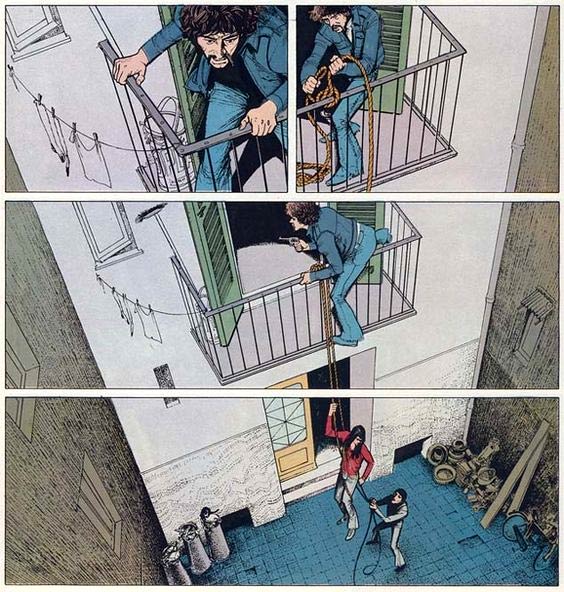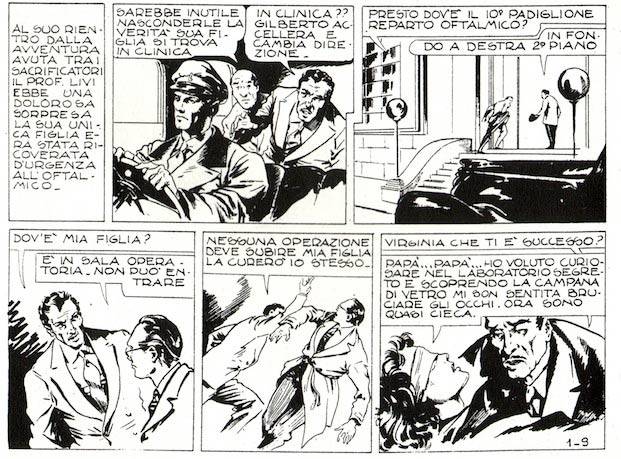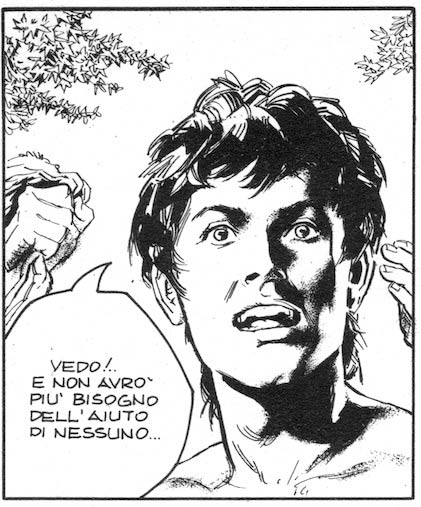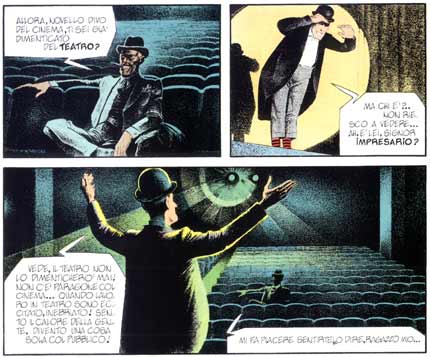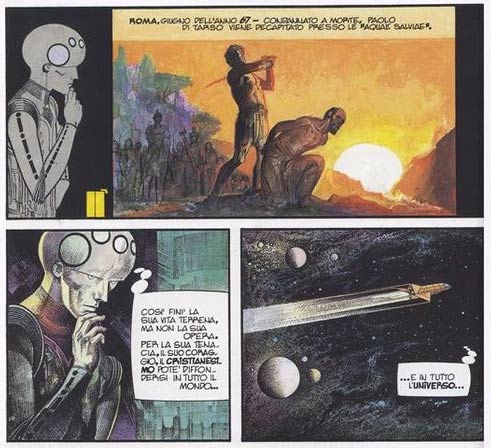Il Commissario Spada
Gianni De Luca was born in Gagliato, but he was raised in Rome from the age of 6. He provided the illustrations for an edition of Hector Malot's novel 'Sans Famille' in 1945, and enrolled at the Faculty of Architecture in 1947. He gave up his studies after about two years to spend all his time on drawing comics. His first published story was 'Il guercio sconfitto' in Tam-Tam volume 2 by SEMCI in March 1946. He then published the comic books 'Anac il distruttore' and 'La meravigliosa invenzione' in the 'Albi Roma' series of the publishing house A.V.E. in 1946. In that same year, he made is first appearance in A.V.E.'s magazine Il Vittorioso with header designs. He made his actual debut in this weekly's pages in 1947 with the serial 'Il Mago Da Vinci'. This was followed by stories with the characters 'Ted' and 'Jim Brady', as well as the feature 'Battaglia ai ciuffi bianchi' with Alberto Malfatti for the younger readers.
Jim Brady - Il Fiore Della Morte
In 1948-1949, he made illustrations for Jacovitti's series of school diaries 'Diario Vitt', that were also published by A.V.E. He subsequently made fantasy serials like 'I naufraghi del Mc. Person', 'Prora vichinga', 'L'impero del sole', 'La sfinge nera' and 'Il tempio delle genti', that show influences of Hal Foster and Alex Raymond. He revamped his style for the 1951 story 'Gli ultimi della Terra' ('The last on earth'), and returned to a more classical rendition for the historical stories 'Il cantico dell'arco' and 'Le braccia di pietra' ('The Stone Arms') in 1952.
L'Ultima Atlantide
He continued to contribute serials to Il Vittorioso until about 1957, including the thriller 'Giallo alla 14ª strada' (text by Mario Basari), in which he showcased his talent for drawing expressive characterizations of faces, and 'Ragazzi di Ungheria' (text by Lino Monchieri). Throughout his career, De Luca managed to apply the styles and techniques that befitted the stories he was assigned to draw.
By 1953, De Luca had also begun a long collaboration with Il Giornalino, the children's magazine of Edizioni Paoline. His first story was 'La leggenda della montagna' ('The legend of the mountain'), for which he used a photo-realistic technique based on light and dark. Between 1955 and 1959, he drew the feature 'La più grande storia mai raccontata' ('The greatest story ever told'), that featured comic versions of Bible stories. This was followed between 1960 and 1968 by 'I dodici in cammino', a history of the Christian Church. During the 1960s, he was however mainly occupied with illustrating.
He returned to comics for a first time in 1967, with the melodramatic story 'L'ultima Atlantide', and then for good in 1969 with the western feature 'Bob Jason'. Il Giornalino first published De Luca's best-known serial from 1970. Together with writer Gian Luigi Gonano, he created the adventures of crime fighter 'Il Commissario Spada'. The series was groundbreaking in many ways, since it introduced subjects like violence, organized crime, satanic sects, terrorists and murderers to the pages of a Catholic magazine for young readers, that was at the time mainly distributed in parishes. However, the duo continued the adventures of their hero until 1982.
Il giornalino di Gian Burrasca
Other notable work by De Luca is the Shakespearean cycle he made with Raul Traverso from 1975 to 1978. This includes faithful adaptations of plays like 'The Tempest', 'Hamlet' and 'Romeo & Julia'. In the 1980s, he made 'Il giornalino di Gian Burrasca' with Claudio Nizzi, based on the novel of the same name by Vamba, and an adaptation of the Paulo Ferrarini novel 'La Freccia Nera' (1988).
Paulus
He also embarked upon the ambitious saga 'Paulus' with Tommaso Mastrandrea, dealing with the Acts of the Apostles from a futuristic viewpoint. He additionally made comics biographies of Marilyn Monroe and the Italian comedian Totò. Gianni De Luca's series 'I Giorni Dell'Impero', that was set in imperial Rome, was published posthumously, in its unfinished state.



